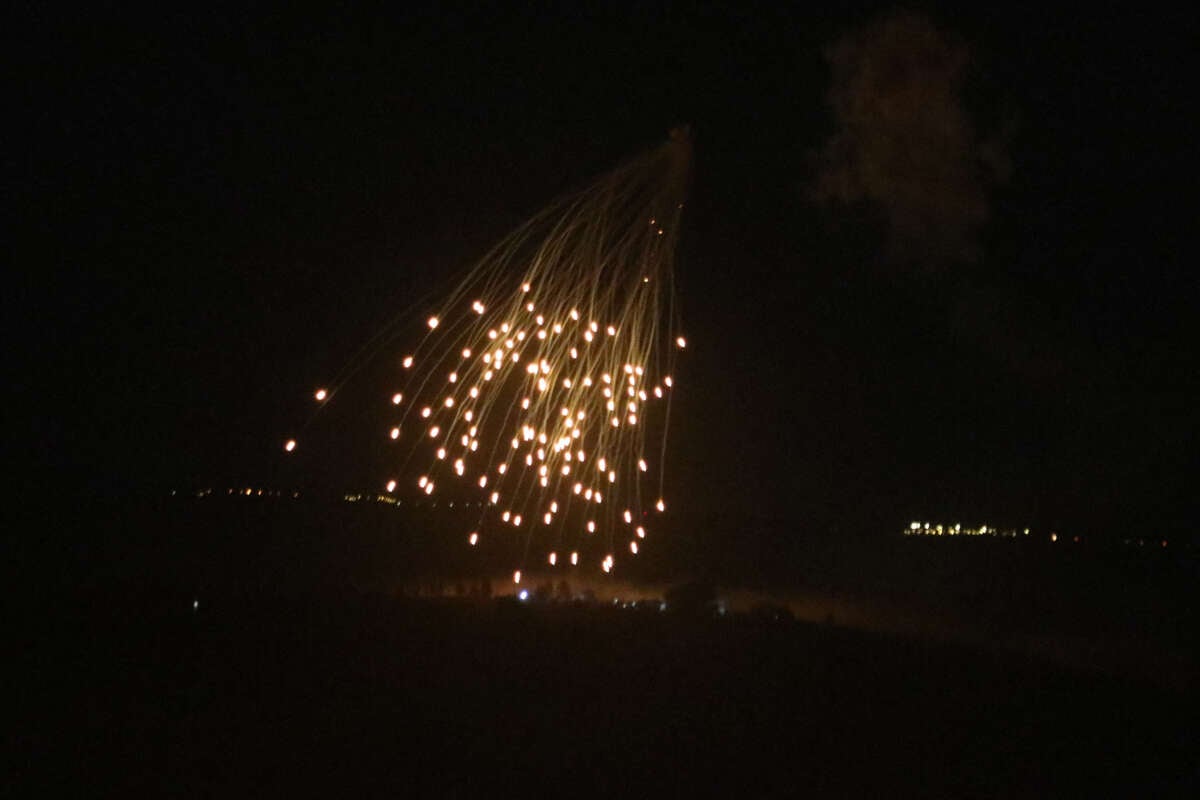Israeli forces have deployed an extremely incendiary and dangerous wartime chemical across at least 17 municipalities, including residential areas, spanning the southern Lebanon border just since October of 2023, a new report finds.
Human Rights Watch has found that the Israeli military has been using white phosphorus munitions on these towns — from which tens of thousands of people have been forced to flee due to months of fighting — in a way that could be considered a violation of international law. At least five municipalities that Israel has used white phosphorus on are populated residential areas, the Human Rights Watch report found.
Lebanon’s health ministry has documented 173 people injured by white phosphorus exposure since October. This includes cases like two people in the village of Boustane who were in their homes when Israel attacked the town with white phosphorus on October 15 and had to be rushed to the hospital for asphyxiation.
“I had my windows open while driving, and the smoke went into the car,” one photographer told Human Rights Watch of his experience inhaling white phosphorus from one of several Israeli attacks on Kafr Kila.
“I felt my stomach turning. My throat, lungs, and stomach felt awful. I got diarrhea that night. After that I couldn’t eat for a while, for about five days or so,” he said, adding that he slept for two days afterward and still has a cough.
White phosphorus is an extremely caustic chemical that causes severe injuries even if it doesn’t come in direct contact with humans. Inhalation of white phosphorus can cause asphyxiation and permanent respiratory damage, breakdown of bones, and extreme pain. Because white phosphorus can burn at temperatures of up to 1600 degrees Fahrenheit, it also has horrific effects when it comes into direct contact with humans, burning through clothing, flesh, and bone.
The substance also causes damage to buildings, vehicles and agricultural land, lighting homes on fire and contaminating land. Its effect on agricultural land is so severe that some experts have likened the use of white phosphorus to environmental terrorism because of its ability to potentially permanently destroy fertile land.
Use of white phosphorus on residential areas is a violation of international law because of its indiscriminate effect on civilians.
Amnesty International has previously concluded that Israel has likely committed a war crime with its use of phosphorus in southern Lebanon in October. A Washington Post investigation later found that the phosphorus shells used in that attack were manufactured in the U.S.
“Many people started getting scared of buying anything from the village or from the south because they’re afraid it may have been hit with [white] phosphorus,” said South Lebanon photographer Ramiz Dallah, who inhaled white phosphorus in a December attack on the Shebaa valley and village. “People didn’t want to buy produce from our village.”
Rights groups have documented use of white phosphorus by Israeli forces on both Lebanon and Gaza in recent months. Israel has used white phosphorus on civilians and agricultural land for decades, and has recently escalated a concerted effort to destroy farmland in Gaza and render it polluted and infertile amid its genocide.
The mayor of Boustane told Human Rights Watch that, while there were formerly 900 people in the town when hostilities first broke out, so many have been forced to flee that there are now only four people left. Data analyzed by the human rights group suggests that the phosphorus attack was what spurred many to leave. Other towns, like Kafr Kila, have similarly seen a mass exodus following white phosphorus attacks.
White phosphorus is often used in war to create a smoke screen. However, there are ways to create smoke screens that are not as dangerous as white phosphorus, as Human Rights Watch points out — including alternatives that are manufactured by Israeli companies.
“Israel’s use of airburst white phosphorus munitions in populated areas indiscriminately harms civilians and has led many to leave their homes,” said Human Rights Watch Lebanon researcher Ramzi Kaiss in a statement. “Israel forces should immediately stop using white phosphorus munitions in populated areas, especially when less-harmful alternatives are readily available.”
The call for Israel to limit its white phosphorus use comes as Israel appears poised to escalate attacks on Lebanon and Hezbollah forces, with Israeli Security Minister Itamar Ben-Gvir calling for war and the destruction of Hezbollah this week.
Media that fights fascism
Truthout is funded almost entirely by readers — that’s why we can speak truth to power and cut against the mainstream narrative. But independent journalists at Truthout face mounting political repression under Trump.
We rely on your support to survive McCarthyist censorship. Please make a tax-deductible one-time or monthly donation.
